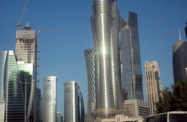With the government and international agencies alike predicting GDP to expand by almost 20% this year, and a budget surplus in the double-digit billions, Qatar’s economy is set to outstrip nearly all others around the world in 2011. Just about the only cloud on the horizon is the return of demand-driven inflation, though even this concern seems likely to dissipate in the face of sustained growth.
In an address given by the minister of finance and economy, Yousef Hussein Kamal, on behalf of the prime minister and foreign minister, Sheikh Hamad bin Jassim bin Jabor Al Thani, on March 3, delegates attending a meeting of the Institute of International Finance in New Delhi were told Qatar’s GDP would increase by at least 18% in 2011. The IMF is even more upbeat, forecasting that Qatar’s economy will grow by 18.6% this year, on top of the 16% expansion in real GDP in 2010.
Some – though no means all – of this growth is being powered by liquefied natural gas (LNG), with Qatar’s annual output reaching its planned maximum level of 77m tonnes at the end of last year, up from 56m tonnes at the close of 2009.
According to a recent report by the Arab Monetary Fund, an additional spur for the economy is the higher level of state investment in infrastructure projects and other measures taken in 2010 to prevent any ripple effect from the global recession. Though this increased state spending may reduce the 2010/11 budget surplus, it should still come in at around 8.7% of GDP, the Abu Dhabi-based agency said on March 8, equating to some $12bn.
Even the forecast growth rates and budgetary surplus could prove to be on the conservative side, with oil trading well above the $55-per-barrel base rate used by the government in its budgetary projections – indeed, as of March 17 benchmark Brent crude was trading at nearly double that level, at just under $110 per barrel.
While the economy is expected to post significant growth, with this comes an old foe – inflation. In late January the finance minister forecast that inflation would remain fairly flat for 2011, with prices expected to rise by just 1% at the most. Though a turnaround from the 2.4% deflation experienced last year, the projected rise is a far cry from the double-digit increases seen in the middle of the last decade.
The minister told reporters that if there was excess liquidity fuelling demand, “then there will be intervention from the central bank because we don’t want the inflation that we experienced in 2006 and 2007,” he said.
While there have not been steep price rises so far in 2011, early indications are that the Ministry of Finance’s target may be exceeded, with data released on March 1 showing inflation in January was running at 1.6% year-on-year. Though not a dramatic spike, it is a reversal of the deflationary cycle and a trend the government and the central bank will undoubtedly be watching.
“I do not believe that managing inflation will present itself as a problem or concern,” Kamal told OBG. “We have the flexibility and resources to exert strict fiscal and monetary control when it is necessary.”
Another issue the central bank will likely be monitoring closely is the level of bad debt held by the country’s lenders. Though most of Qatar’s banks reported strong results for 2010 – with market leader Qatar National Bank alone posting a 35.7% jump in net profits and the banking and financial sector as a whole seeing profits rise by 25% – many also had to make greater provision for non-performing loans last year. Banks reported more than $275m of impairment losses on loans and advances last year, and between them had $2bn worth of total provisions for bad or doubtful loans in January, up from the $1.8bn as of November.
With the sector showing black ink in the ledger again and easily able to carry what bad loans it may still have after last year’s pruning, this pillar of the economy is expected to expand strongly in 2011.

